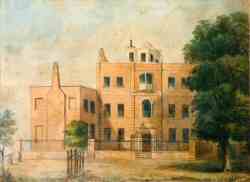Contents
Blackheath: A middle class estate of the 18th and early 19th centuries
by Neil Rhind
Blackheath Village
Moving down the decades Morden College turned its attention to another parcel of its land – a half moon of grass and fields on the south of the Heath, to the west of what became Blackheath Village, - Grotes Buildings, and Grotes Place. By this time (1770) Blackheath attracted not only men of business and industrial manufacture but also a sizeable number in the military services and the mercantile marine.
The shipbuilding, ordnance and munitions factories at Deptford, Blackwall, and Woolwich provided employment for men of all classes, but in this part of England in particular, scientists and designers. Shipping attracted a number of disciplines: financiers, ship owners, naval architects, builders, insurers, victuallers, import and export merchants, and the officers required to take the fleets to sea and bring them back again.
Blackheath seemed to attract Scotsmen: men in shipping and West India merchants, sometimes plantation owners. Many were Edinburgh merchants anxious to demonstrate their loyalty to the Crown in the 1740s who, to avoid Jacobite taint, came to London. Curiously, in turn they brought to Blackheath their own activities, including those of the masonic lodge and the distinctive Scottish game of golf – their club was to play on Blackheath from about 1745 until 1923, when the Royal Blackheath Golf Club moved to Eltham. It was these men who were to take the new Morden College houses, to be called Grotes Buildings after the leaseholder one Andreas Grote, a Bremen-born banker living then in some style in another College property, Point House in West Grove. Grote, in due course, lent his name for another street, developed in the 1830s and now called Grotes Place.
